KNOW the Operation and the Different Types of POTENTIOMETERS (Pots) for Electric Guitar: Audio vs Linear, 250K vs 500K. Potentiometers for Single or Single Coil Pickups, and for Double Coil or Humbucker Pickups.
On this occasion we will deal with the topic of nothing less than potentiometers for electric guitar. Since, as we know, taking care of the signal from our guitar on its way to the amplifier is always very important, and if it must go through low-quality components, this will have a negative effect on the signal itself.
In addition investing in good potentiometers is not expensive at all, because a quality potentiometer is usually between 5 and 8 dollars, and the installation is not very complicated. It is simply a matter of redoing the solders in the same way in which they were previously. You can make notes and photographs before making a change of these components, to keep everything exactly as it was.
But below I will detail the guidelines that we must know before getting down to work, the most suitable types of pots for tone and volume, and the most appropriate for single coil and double coil pickups. Because in life, everything we do recklessly has a high chance of going wrong.
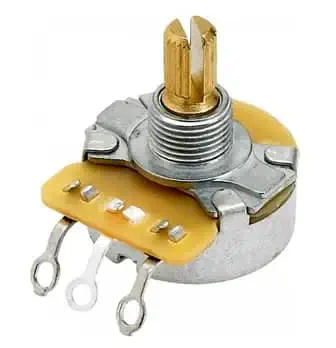
Potentiometers for Electric Guitar: Linear and Audio
There are two types of pots: linear and logarithmic. The logarithmic potentiometer is usually detailed with the letter A, and the linear with the letter B. Both a linear and a logarithmic potentiometer will deliver 0% at minimum, and 100% at maximum.
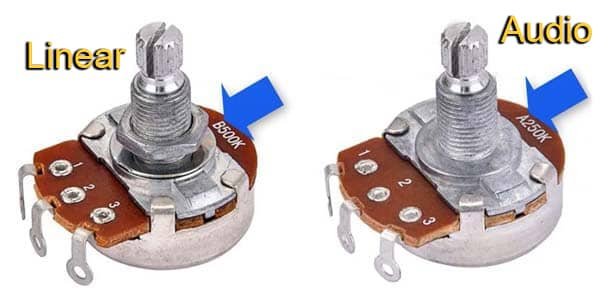
Regarding this, there is no difference between one or the other, within the same range of qualities. Their differences are found in the intermediate zone between their minimum and their maximum. In linear pots, the resistance increases continuously and progressively, while in logarithmic pots, the resistance increases exponentially.

The human ear is said to be more logarithmic, or exponential, than linear. This is very easy to understand with an example. If we have a backpack on our back, and another person fills it with sand in a linear fashion like an hourglass would, we will not feel any weight until the backpack has been loaded with a certain amount of sand.
However, if the backpack is loaded exponentially with increasingly larger stones, we will notice the weight changes more noticeably as the backpack is loaded.
Consequently, the audio potentiometer delivers only a small part of its potential towards the middle of its travel, although contradictorily our ear perceives the audio progressively. And towards the end of the travel, the potentiometer delivers most of its potential.
Pot of Audio for Volume
For this reason, logarithmic potentiometers are often used for volume controls, as the ear perceives a volume increase that is gradual, even though it is not.
In fact, the logarithmic potentiometer is simply known as an audio potentiometer.
On the other hand, the logarithmic potentiometer allows us to smooth out the distortion of our guitar without having to lower the volume too much, since much of its range is delivered at the end of the potentiometer’s travel, allowing the distortion to be smoothed out considerably by lowering this control slightly.
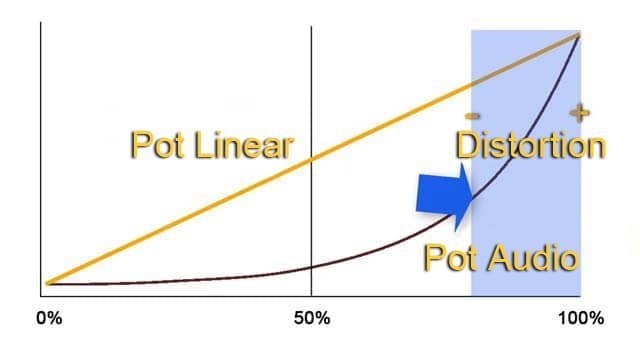
Conversely, if the volume control is linear, it will deliver too much audio perceptible to the ear at the beginning of its range. And if this type of potentiometer is at maximum, it will not cut distortion as effectively if we lower it slightly, as a logarithmic potentiometer would.
Pot of Linear for Tone
However, the linear pot is often used for tone controls, because an exponential pitch increase is less accurate and effective, and the linear pot performs better in these functions.
In any case, when it comes to the guitar, there is almost nothing that is 100 percent set in stone, as everyone’s tastes vary.
So, if someone decides to have an exponential tone pot instead of a linear one, and a linear volume pot instead of an exponential one, after what has been demonstrated, they know very well that they must do the opposite of what has been detailed above.
Checks
I have previously commented that the logarithmic potentiometer is generally detailed with the letter A, and the linear one with the letter B. But depending on the age or origin of the potentiometer, these terms can be reversed. So when buying it is better to make sure that it is a linear or logarithmic pot regardless of the references A or B.
In the event that the pot is already installed, the most reliable thing would be to measure its resistance while we operate the potentiometer. If it increases progressively, it would be a linear potentiometer, and if it increases exponentially, doubling the resistance progressively, it would be a logarithmic potentiometer.
In the case of carrying out the work of installing the potentiometers ourselves, these concepts are vital. In any case, we can always choose to leave this job to a professional who is an expert in these functions, or even an electronic technician can lend himself to perform this function without major problems at a fairly affordable cost, since it would not be a difficult operation.
However, it is always beneficial to know all these issues, to effectively guide the technician or luthier of what we really need. Although in general it would be a logarithmic potentiometer for volume, and a linear one for tone controls.
Electric Guitar Potentiometers: 250K vs 500K
We move on to the subject of kilohms, which in general would also be of two types for passive pickups or standard electromagnetic pickups: 250K and 500K.
The lower resistance 250K potentiometers filter out the higher frequencies, and the 500K ones let these frequencies through better. For this reason, pickups with a dull and poorly defined sound, such as double-coil or humbucker pickups, usually mount 500K potentiometers. And the treble and defined pickups like the traditional single coil pickups, usually mount 250K potentiometers, to soften these frequencies that could be annoying.
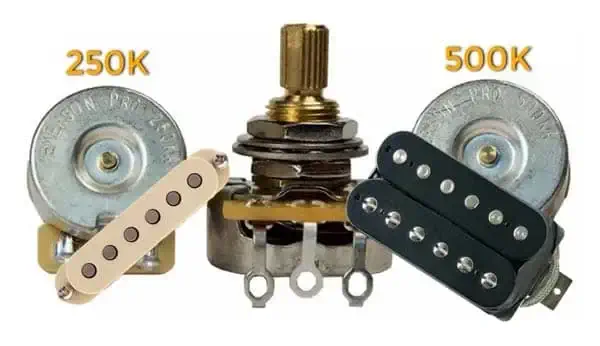
But if we notice that the sound of our guitar is somewhat strident with 500K potentiometers, we can mount 250K to obtain a slightly softer and warmer tone, and vice versa. If we notice that the sound is not very defined with 250K potentiometers, we can mount of 500K to have a treble or more penetrating tone.
Always Check Potentiometer Measurements
Once you are familiar with all these concepts, you should check the dimensions of the potentiometers before making a purchase to ensure that they are the same size as the potentiometers they are replacing.
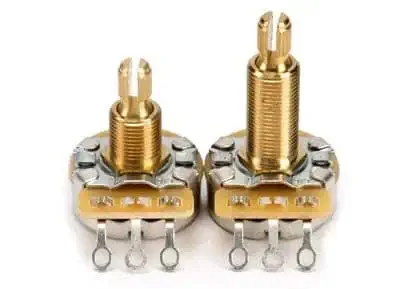
We must also check how the buttons are attached to the potentiometer, as there are both knurled and smooth shafts. The splined shafts are designed for snap-on buttons, and the smooth shafts are attached to the button by a small screw housed in the side of the button.
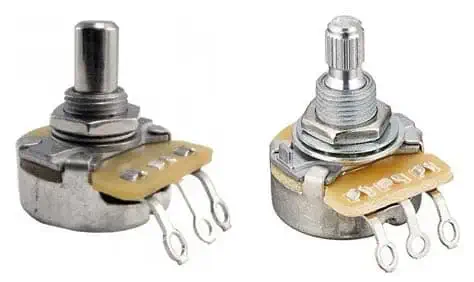
Something to keep in mind if we want to keep the original buttons, or if we also want to change them.
Push pull potentiometers are typically operated by pulling the knob out to accommodate additional wiring, typically coil-splitting systems on dual-coil pickups.
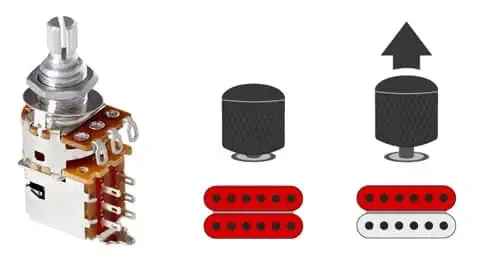
Personally I don’t like this type of potentiometers, due to the fact that they tend to be too soft, and their adjustment can be very easily modified unconsciously or accidentally.
Better to place a quality standard potentiometer, and install an independent switch for wiring derivation functions.
